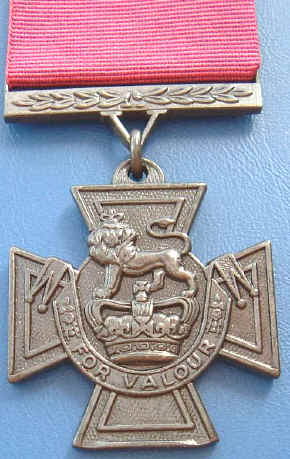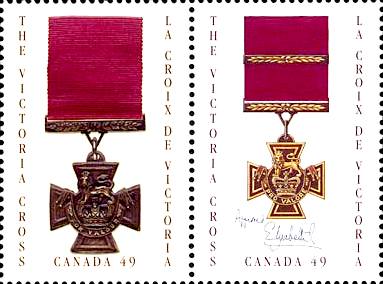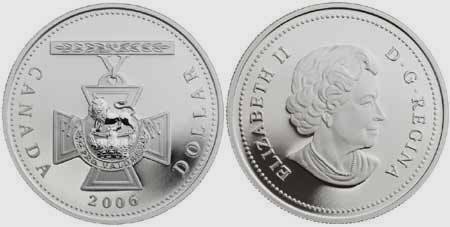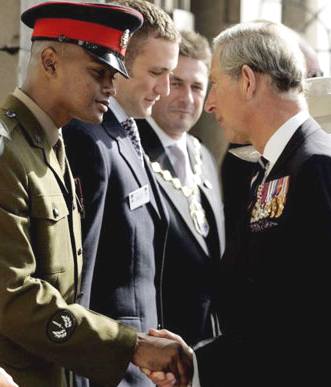|
VICTORIA CROSS
|
|||||||||||||||||||||||||||||||||||||||||||||||||||||||||||||||||||||||||||||||||||||||||||||||||||||||||||||||||||||||||||||
|
HOME | BIOLOGY | FILMS | GEOGRAPHY | HISTORY | INDEX | INVESTORS | MUSIC | SOLAR BOATS | SPORT |
|||||||||||||||||||||||||||||||||||||||||||||||||||||||||||||||||||||||||||||||||||||||||||||||||||||||||||||||||||||||||||||
The Victoria Cross (VC) is the highest recognition for valour "in the face of the enemy" that can be awarded to members of the British and Commonwealth armed forces of any rank in any service, and civilians under military command. It is also the highest award in the British Honours system.
The decoration is a cross pattée, 1.375 inches (35 mm) wide, bearing a crown surmounted by a lion, and the inscription "FOR VALOUR". This was originally to have been "FOR BRAVERY", until it was changed on the recommendation of Queen Victoria, who thought some might erroneously consider that only the recipients of the VC were brave in battle. The decoration, suspension bar and link weigh about 0.87 troy ounces (27 g).
Victoria Cross
The recipient's name, rank, number and unit are engraved on the back of the suspension bar, and the date of the act for which it was awarded on the back of the cross.
The ribbon is crimson, 1.5 inches (38 mm) wide. The original 1856 specification for the award stated that the ribbon should be red for army recipients and blue for naval ones. However the dark blue ribbon was abolished with the formation of the Royal Air Force on 1 April 1918, and living recipients of the naval version were required to exchange their ribbons for red ones.
Historical background
The VC was created by Royal Warrant on 29 January 1856, backdated to 1854 to recognise acts of valour during the Crimean War of 1854-1855. The first award ceremony was on 26 June 1857.
It is widely believed that all VCs are cast from the bronze cascabels of two cannon of Chinese origin that were captured from the Russians at the siege of Sevastopol, except during the First World War when metal from guns captured from the Chinese during the Boxer Rebellion was also used. However, a 2006 book on the VC's history by historian John Glanfield calls the traditional account into question, arguing that it is impossible that the metal used for VCs made before 1914 really does come from the Sevastopol guns. Also, the Sevastopol metal went missing between 1942 and 1945, when another source of metal was used to make five Second World War VCs.
The barrels of the cannon in question are stationed outside the Officers' Mess at the Royal Artillery Barracks at Woolwich. The remaining portion of the only remaining cascabel, weighing 358 oz (10 kg), is stored in a vault by 15 Regiment Royal Logistic Corps at Donnington, Telford. It can only be removed under armed guard.
It is estimated that approximately 80 to 85 more VCs could be cast from this source. A single company of jewellers, Hancocks of London, has been responsible for the production of every VC awarded since its inception.
In 1856 Queen Victoria laid a Victoria Cross beneath the foundation stone of Netley Hospital. When the hospital was demolished in 1966 the VC, known as "The Netley VC", was retrieved and is now on display in the Army Medical Services Museum, Ash, near Aldershot.
Awards
A total of 1,355 Victoria Crosses have been awarded since 1856. This figure is made up of 1,351 people who have earned the VC, plus three bars (awarded to people who receive the decoration a second time), and one award in 1921 to the American Unknown Soldier of the First World War. (The British Unknown Warrior was reciprocally awarded the US Medal of Honor.)
Originally, the Victoria Cross could not be awarded posthumously, and could not be awarded to Indian or African troops (although it could be awarded to their European officers). In 1905 it was made available to be awarded posthumously. Not until the 20th century was it made available to all troops in the service of the Crown (the first Indian soldier, Khudadad Khan, received it in 1914).
The largest number of VCs awarded in a single day was 24 on 16 November 1857, at the relief of Lucknow. The largest number awarded in a single action was 11 at Rorke's Drift on 22 January 1879. The largest number of Victoria Crosses awarded in a single conflict was 634 during the First World War.
Since the end of the Second World War the VC has been awarded only 12 times. Four were awarded during the Korean War, one in the Indonesia-Malaysia confrontation in 1965, four to Australians in the Vietnam War, two during the Falklands War in 1982, and one in the Second Gulf War in 2004.
Only three people have been awarded the Victoria Cross twice: Noel Chavasse and Arthur Martin-Leake, both members of The Royal Army Medical Corps, and New Zealander Charles Upham. The second award is designated by a bar worn on the suspension ribbon of the original decoration and this is thus known as a "VC and Bar". Since a small cross device is worn on the VC ribbon when worn alone, a recipient of the VC and Bar would wear two such crosses on the ribbon.
Another New Zealander, Flying Officer Lloyd Allan Trigg, has the distinction of being the only serviceman ever awarded a Victoria Cross on evidence solely provided by the enemy, for an action in which there were no surviving Allied witnesses. The recommendation was made by the captain of a German U-boat sunk by Trigg's aircraft.
Lieutenant-Commander Gerard Broadmead Roope was also awarded a Victoria Cross on recommendation of the enemy, the captain of the Admiral Hipper, but there were also numerous surviving Allied witnesses to corroborate his actions.
Victoria Cross featured on a Canadian postage stamp
As the VC is awarded for acts of valour "in the face of the enemy", it has been suggested by some that the changing nature of warfare will result in few VCs being awarded. Only one in ten VC recipients in the 20th century is said to have survived the action for which they received the VC. Following the death of Captain Umrao Singh, the last surviving Indian holder of the VC, in November 2005 there are currently only twelve surviving holders of the VC – six British, two Australians, and four Gurkhas – eight of them for exploits during the Second World War.
The corresponding honour for acts of valour that do not qualify as "in the face of the enemy" is the George Cross, which ranks next after the VC in the order of precedence.
Between 1858 and 1881, the Victoria Cross could be awarded for actions taken "under circumstances of extreme danger" not in the face of the enemy. Six such awards were made during this period - five of them for a single incident (a shipwreck off the Andaman Islands in 1867).
In recent years, several Commonwealth countries have introduced their own honours systems, separate from the British Honours System. Australia, Canada and New Zealand have each introduced their own decorations for gallantry and bravery, replacing British decorations such as the Military Cross with their own awards. Most Commonwealth countries, however, still recognise some form of the Victoria Cross as their highest decoration for valour.
Australia was the first Commonwealth nation to create its own VC, on 15 January 1991. Although it is a separate award its appearance is identical to its British counterpart. Canada followed suit when in 1993 Queen Elizabeth signed Letters Patent creating the Canadian VC, which is also similar to the British version, except that the legend has been changed from "FOR VALOUR" to Latin "PRO VALORE" (it can be seen on the Canadian postage stamp on this page, along with the Queen's signature creating the Canadian VC).
New Zealand was the third country to create the VC as part of its own honours system. While the New Zealand VC is technically a separate award, the decoration is identical to the British design, including being cast from the same Crimean War gunmetal as the British VC. As of 2006, none of these VCs have been awarded.
Awards of the Victoria Cross are always announced in the pages of the London Gazette.
Victoria Cross after 2000
In March 2002, it was widely reported in the British media that the VC was to be awarded to an unnamed Regimental Sergeant-Major in the 22nd Special Air Service (SAS) Regiment, for his involvement in fighting in the Tora Bora cave complex in November 2001. There was some debate over whether he should be named - a position favoured by the Secretary of State for Defence, Geoff Hoon, but a compromise was reached that his name, and some specific details of the action, would be withheld from the official announcement in the London Gazette. However, this did not happen; the VC award was never confirmed, and he and another member of the SAS, who had also been discussed as a possible VC recipient, were awarded Conspicuous Gallantry Crosses in October 2002 instead.
In April of 2004 the VC awarded to Sergeant Norman Jackson, RAF, in 1944, was sold at auction for £235,250.
In late 2004, Duncan Gordon Boyes VC and nine other recipients were publicly celebrated on posters on the Victoria line of the London Underground. That same year, a national Victoria Cross and George Cross memorial was installed in the Ministry of Defence building on Whitehall in London.
On 18 March 2005, Private Johnson Gideon Beharry of the 1st Battalion, Princess of Wales's Royal Regiment became the first recipient of the VC since the posthumous award to Sgt Ian McKay, 3rd Battalion, Parachute Regiment in 1982. Beharry was cited for "valour of the highest order" during the Iraq War. He is included in a list of more than 140 British troops awarded honours for roles in Iraq, Afghanistan, Northern Ireland, the Balkans, Liberia, Sierra Leone, the United Kingdom and Congo.
In August of 2005, Ernest Alvia ("Smokey") Smith, Canada's last surviving VC recipient, died. In November 2005, Umrao Singh, the last survivor of India's 40 VC recipients, died.
Canadian Victoria Cross displayed on a Canadian Silver Dollar in 2006
On 24 July 2006, an auction at Bonhams in Sydney of the VC awarded to Captain Alfred Shout fetched a world record hammer price of $A1 million. Captain Alfred Shout was awarded the VC posthumously in 1915 for hand-to-hand combat at the Lone Pine trenches in Gallipoli Turkey. The buyer (Kerry Stokes) has indicated that it will be displayed at the Australian War Memorial with the eight other VCs awarded to Australians at Gallipoli.
On 16 October 2006, it was reported in The Sun newspaper that Corporal Bryan Budd was being considered for the award of a posthumous VC for actions against the Taliban in Afghanistan. The newspaper said that a final decision would not be reached until a citation is made early next year.
AnnuityHolders of the Victoria Cross or George Cross are entitled to an annuity, the amount of which is determined by the awarding government. Since 2002, the annuity paid by the British government is £1,495 per year. As at January 2005, under the Canadian Gallantry Awards Order, members of the Canadian Armed Forces, or people who joined the British forces before 31 March 1949 while domiciled in Canada or Newfoundland, receive $3,000 per year. The Australian Government provides the two surviving Australian recipients a Victoria Cross Allowance under Subsection 103.4 of the Veterans' Entitlements Act 1986. In January 2006 the amount was $A3,230 per year which is indexed annually in line with Australian Consumer Price Index increases.
Forfeited VCs
Until the 1920s, the rules relating to the Victoria Cross allowed for the expulsion of a VC recipient from the list of people receiving the honour, and the forfeiture of their pension, if they committed "discreditable acts". The rules have since been changed to prevent such expulsions, and the eight men who lost their VCs were restored to official lists. This change in policy was insisted upon by King George V and reflected the increasing difficulty in attaining the award. He commented that, should a VC recipient later in his life be convicted for a capital crime, that individual should still be permitted to wear the decoration on the gallows.
Theft of the VC
Given the rarity of the Victoria Cross and the fact they are rarely sold, these decorations are highly prized on the black market by medal collectors. Several VCs have been stolen, and being valuable have been placed on the Interpol watch-list for stolen items.
One was the VC awarded to Milton Fowler Gregg, which was donated to the Royal Canadian Regiment Museum in London, Ontario Canada in 1979. It was stolen on Canada Day, (July 1, 1980), when the museum was overcrowded, and has been missing since. A VC awarded in 1917 to Corporal Filip Konowal, a Canadian soldier who had emigrated from Ukraine in 1913, was stolen from the same museum in 1973, and was not recovered until 2004.
Official collections
The Victoria Cross Gallery in the Australian War Memorial contains most of the VCs awarded to Australians, and 60 VCs in all, the largest such publicly held collection in the world. Following the 2006 purchase and donation by Kerry Stokes of Capt Shout's medal, the Victoria Cross Gallery now has all nine VCs awarded to Australians at Gallipoli.
Unofficial collections
British businessman and politician Michael Ashcroft is reported to have amassed a private collection of over one hundred VCs, which is probably the largest private collection of such medals ever accumulated.
The Prince meets Private Johnson Beharry VC (left) and Trooper Chris Finney GC (right) before a service to remember holders of the Victoria Cross and George Cross
TermsFor most conspicuous bravery or some daring or pre-eminent act of valour or self-sacrifice or extreme devotion to duty in the presence of the enemy.
BarA bar is awarded for additional acts of bravery. Only 3 have been awarded, none to a Canadian.
DescriptionA cross pattee, 1.375 inches across, with a dark brown finish. Made from cannons captured from the Russians during the Crimean War.
ObverseThe obverse displays the Royal Crown surmounted by a lion guardant. Below the crown, a scroll bearing the inscription: FOR VALOUR.
ReverseRaised edges with the date of the act engraved within a raised circle.
MountingA straight bar (ornamented with laurels), slotted for the ribbon, has a V-lug below. A small link joins the V-lug to a semi-circular lug on the top of the cross.
RibbonThe crimson ribbon is 1.5 inches wide and a miniature cross is worn on the ribbon in undress. The ribbon was dark blue for naval recipients until 1918 with Able Seaman William HALL, RN, being the only Canadian VC winner to wear the blue ribbon.
NamingThe recipient's rank, name and regiment are engraved on the reverse of the mounting bar.
DatesThe medal was instituted on 05 February 1856 with awards retroactive to 1854. The first award to a Canadian was in February 1857, to Lt. Alexander DUNN (Charge of the Light Brigade).
IssuedThere have been 1,351 Victoria Crosses and 3 Bars awarded worldwide, 94 to Canadians (Canadian-born or serving in the Canadian Army or with a close connection to Canada).
RAF VICTORIA CROSS AWARDS
Chronological order of the 23 awards of the VC to airmen of RAF bomber squadrons.
The Victoria Cross is the highest and most prestigious award for gallantry in the face of the enemy that can be awarded to British and Commonwealth forces.
"It is ordained that the Cross shall only be awarded for most conspicuous bravery, or some daring or pre-eminent act of valour or self-sacrifice or extreme devotion to duty in the presence of the enemy."
There is no barrier of colour, creed, gender or rank to winning a Victoria Cross. 626 VCs were awarded in WW1. 40 were awarded for action at Gallipoli or the Dardanelles.
CANADIAN VC RECIPIENTS
Full citations to these awards are recorded in Valiant Men, Canadian War Museum Historical Publications, A.M. Hakkert Ltd.
Prior to the South African War (4)DUNN,
Alexander Robert The South African (Boer) War (4)COCKBURN,
Hampden Z.C. First World War (70)ALGIE,
Wallace Lloyd Second World War (16)BAZALGETTE,
Ian W.
Victoria Cross Winners Associated with CanadaBEET,
Barry Churchill
LINKS and REFERENCE
GENERAL HISTORY
MARITIME HISTORY
A taste for adventure capitalists
Solar Cola - a healthier alternative
|
|||||||||||||||||||||||||||||||||||||||||||||||||||||||||||||||||||||||||||||||||||||||||||||||||||||||||||||||||||||||||||||
|
This
website
is Copyright © 1999 & 2007 NJK. The bird The name '1824' is a trade mark of Solar Cola Ltd. All rights reserved. Max Energy Limited is an educational charity. |
|||||||||||||||||||||||||||||||||||||||||||||||||||||||||||||||||||||||||||||||||||||||||||||||||||||||||||||||||||||||||||||
|
AUTOMOTIVE | BLUEBIRD | ELECTRIC CARS | ELECTRIC CYCLES | SOLAR CARS |



